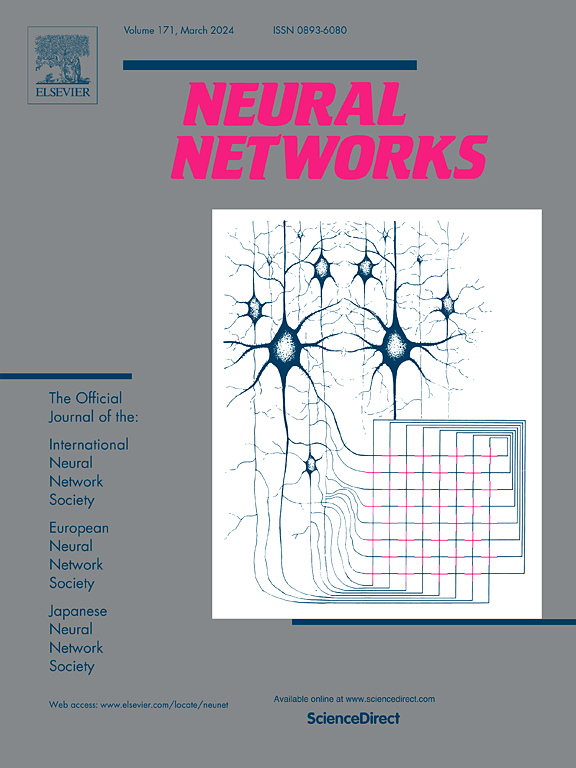RISE-编辑:具有交互式分割功能的旋转不变神经点域,可进行精细高效的编辑
IF 6.3
1区 计算机科学
Q1 COMPUTER SCIENCE, ARTIFICIAL INTELLIGENCE
引用次数: 0
摘要
神经辐射场(Neural Radiance Fields, NeRF)在合成新视图方面显示出巨大的潜力。目前,尽管存在一些初始的可控和可编辑的NeRF方法,但它们在高效和细粒度的编辑能力方面仍然有限,阻碍了NeRF的创造性编辑能力和潜在的应用。本文提出了一种具有交互分割的旋转不变性神经点场,用于精细、高效的编辑。编辑隐式字段是一个重大的挑战,因为改变相应的显式支架的方向-无论是点,网格,体积还是其他表示-可能导致渲染质量的显着下降。利用隐式nerf表示和显式点表示的互补优势,我们引入了一种新的旋转不变神经点域表示。这种表示可以使用笛卡尔坐标学习本地内容,从而在细粒度编辑后显著提高场景渲染质量。为了实现这种旋转不变表示,我们精心设计了一个旋转不变神经逆距离加权插值(RNIDWI)模块来聚合神经点。为了实现更高效和灵活的跨场景合成,我们将传统的NeRF表示分解为两个组件:与场景无关的渲染模块和特定于场景的神经点域。此外,我们提出了一种多视图集成学习策略,将二维不一致的零镜头分割结果实时提升到三维神经点场,无需再训练。通过简单的2D图像点击提示,用户可以有效地分割3D神经点字段并操作相应的神经点,从而实现对隐式字段的细粒度编辑。大量的实验结果表明,我们的方法为用户提供了增强的编辑能力和简化的编辑过程,为新视图提供了逼真的渲染质量,并且在时空效率和编辑功能类型方面超越了相关方法。代码可在https://github.com/yuzewang1998/RISE-Editing上获得。本文章由计算机程序翻译,如有差异,请以英文原文为准。

RISE-Editing: Rotation-invariant neural point fields with interactive segmentation for fine-grained and efficient editing
Neural Radiance Fields (NeRF) have shown great potential for synthesizing novel views. Currently, despite the existence of some initial controllable and editable NeRF methods, they remain limited in terms of efficient and fine-grained editing capabilities, hinders the creative editing abilities and potential applications for NeRF. In this paper, we present the rotation-invariant neural point fields with interactive segmentation for fine-grained and efficient editing. Editing the implicit field presents a significant challenge, as varying the orientation of the corresponding explicit scaffold—whether point, mesh, volume, or other representations—may lead to a notable decline in rendering quality. By leveraging the complementary strengths of implicit NeRF-based representations and explicit point-based representations, we introduce a novel rotation-invariant neural point field representation. This representation enables the learning of local contents using Cartesian coordinates, leading to significant improvements in scene rendering quality after fine-grained editing. To achieve this rotation-invariant representation, we carefully design a Rotation-Invariant Neural Inverse Distance Weighting Interpolation (RNIDWI) module to aggregate the neural points. To enable more efficient and flexible cross-scene compositing, we disentangle the traditional NeRF representation into two components: a scene-agnostic rendering module and the scene-specific neural point fields. Furthermore, we present a multi-view ensemble learning strategy to lift the 2D inconsistent zero-shot segmentation results to 3D neural points field in real-time without post retraining. With simple click-based prompts on 2D images, user can efficiently segment the 3D neural point field and manipulate the corresponding neural points, enabling fine-grained editing of the implicit fields. Extensive experimental results demonstrate that our method offers enhanced editing capabilities and simplified editing process for users, delivers photorealistic rendering quality for novel views, and surpasses related methods in terms of the space–time efficiency and the types of editing functions they can achieve. The code is available at https://github.com/yuzewang1998/RISE-Editing.
求助全文
通过发布文献求助,成功后即可免费获取论文全文。
去求助
来源期刊

Neural Networks
工程技术-计算机:人工智能
CiteScore
13.90
自引率
7.70%
发文量
425
审稿时长
67 days
期刊介绍:
Neural Networks is a platform that aims to foster an international community of scholars and practitioners interested in neural networks, deep learning, and other approaches to artificial intelligence and machine learning. Our journal invites submissions covering various aspects of neural networks research, from computational neuroscience and cognitive modeling to mathematical analyses and engineering applications. By providing a forum for interdisciplinary discussions between biology and technology, we aim to encourage the development of biologically-inspired artificial intelligence.
 求助内容:
求助内容: 应助结果提醒方式:
应助结果提醒方式:


